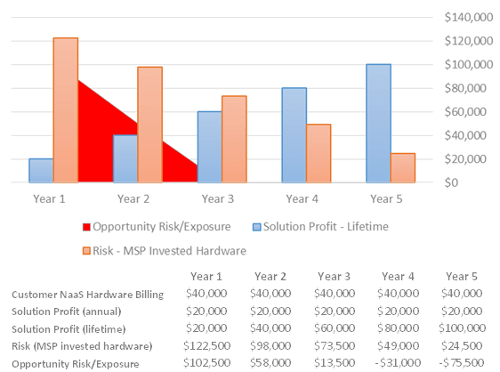
The value in the technology service provider business segment has offset hardware commoditization, leading to the development of the MSP market. This is evidenced by the formation of the managed service industry, creating value outside of simple hardware sales. As the computer networking market matures the profitability in product-only sales constrict, while the operation of these devices and their new capabilities expand, increasing the requirements for advanced knowledge and experience. Because few companies can afford the expert skills to support all areas of their operations, it created a new paradigm for managed service providers (MSPs) — to begin supporting customer-owned technology.
The NaaS Advantage for MSPs
As the MSP market grows and evolves, the focus is on expanding their market position. Like other service providers, they are taking the approach of embedding hardware into their provided services. Minimizing variations within the customer environment may lead to improved customer support as highly variable network designs increase the workload of the support teams. Reducing the number of products to manage and support can easily lead to the reduction of resource requirements and can significantly increase profitability. The increase in resource capabilities to operate and support a deterministic network design can also positively affect service levels and lead to improved customer satisfaction.
The expansion into NaaS offers many advantages, but has some potential concerns, mainly risk. Compared to the typical MSP model, there can be hard costs associated with the service, given the financial investment needed to create a customer’s network infrastructure. At times, an MSP may choose to self-fund this hardware investment using cash or a credit line to fund the purchase. In addition, there is also risk associated with default by the customer. Expansion is always anticipated, but contraction or revocation of service are options as well. While an MSP’s ability to reassign engineering resources is possible, redeploying a unique customer network design to another customer is not. These concerns are understandable, but avoidable.
The Advantage of HPE GreenLake for Networking NaaS Service Packs
If risk is based on the concept of hardware ownership, it can be deferred by keeping title assigned to the manufacturer and not the MSP. Service Packs provide the same recurring revenue opportunity to the MSP, but eliminate the upfront purchase of equipment, so risk is not passed to the MSP. The Service Pack provides the ability to configure a custom network for core, distribution, and edges, but structures it into a riskless model. HPE Aruba Networking assumes the risk, delivering a monthly recurring bill that the MSP can incorporate into their service charges to the customer. Service Packs require no upfront costs or risk of default by the MSP. HPE Aruba Networking provides financial support for MSPs to expand their customer engagements and broaden their recurring revenue streams.
In Figure 1, the profitability for these projects is negatively affected when the MSP directly purchases the hardware. A $100K hardware investment requires $25K in customer billing to cover financing of the hardware, but this does not address the additional risk or the impact of expanding current credit lines by the MSP. In a risk analysis, the first 3 years the debt assumed for the purchase will not cover the hardware purchase value. While the expectation is that the contract will be completed full term, the impact on the company will need to be addressed and accounted for. While the dollars in this example are quite minimal, additional risk is compounded for each customer application and can lead to significant exposure for the company.

Figure 1: Profitability over risk/exposure
Utilizing the HPE GreenLake for Networking NaaS Service Pack removes two aspects that have prohibited many MSP organizations from expanding into the NaaS market. First, the financial risk is removed, helping the MSP to achieve profitability throughout the agreement term. Second, billing to the MSP is monthly and does not require their investment in the hardware. Monthly billing will also address the multi-year risk of default, limiting the exposure to the company.
There are additional benefits that can be expected as the risk of incorporating NaaS into the MSP model is removed. Using HPE GreenLake for Networking, specifically Customer Experience Management, the operation of the entre infrastructure can dramatically streamline the operational aspects for NOC teams utilizing a common device management platform for both wired and wireless network systems. Support requests raised back to HPE Aruba Networking can be viewed from a single pane of glass and resolved using system wide performance and actions, reducing vendor to vendor confusion and lost cycles to determine root cause analysis.
Future Proofing
Another identified risk with NaaS is the concern that solution designs and pricing established at the onset of the contract may limit the evolution of the installation, given product and cost changes occur over the life of the contract. New products and services can be incorporated into future infrastructure expansions. And current pricing models and discounting policies ensure that any changes will not negatively impact the MSP partner or their ability to support their customers into the future. In addition, with the ability to carry the full complement of HPE GreenLake server and storage offerings, the opportunity to grow the customer relationship horizontally is built “Day 1.”
The Final Word
MSPs have already created internal models to support and promote recurring revenue streams. Service Packs allow for riskless entry into the NaaS marketplace. Expansion of the per-customer revenue base, with additional control over device and network design, provides solid revenue opportunities while reducing cost of operations, and increasing operating profit. Service Packs also remove the associated financial investment and assumption of risk from the NaaS sales model, leveraging the financial strength of HPE Aruba Networking to support MSP market expansion.
Increasing revenue and reducing operational costs with no financial burden or risk sounds surprisingly good. Could a NaaS solution be a game changer for your organization?
Read the NaaS overview for partners.
Related Resources
Partner Sales: Best Practices for Selling Network as a Service
Why Should Partners sell Network as a Service?




